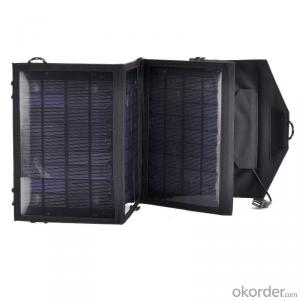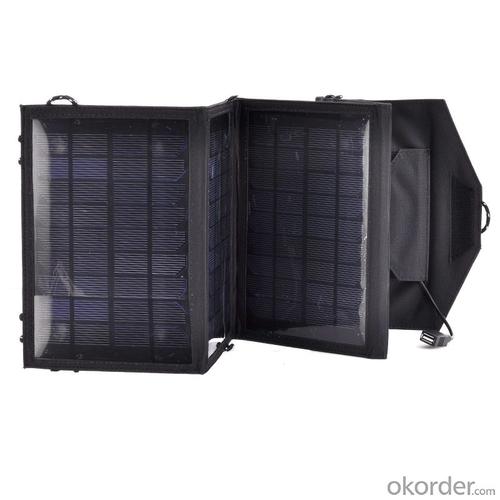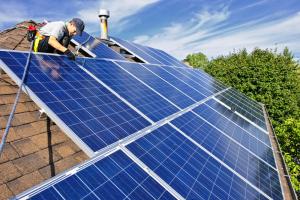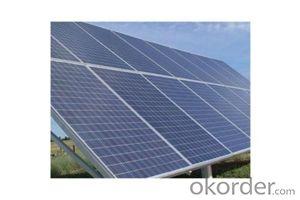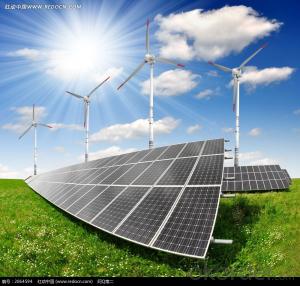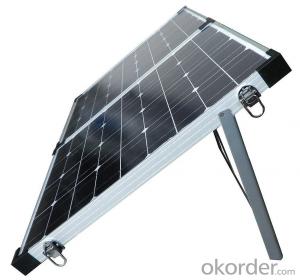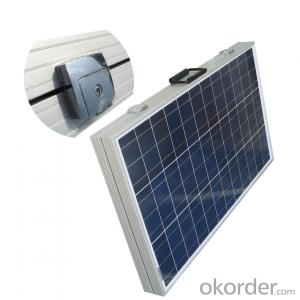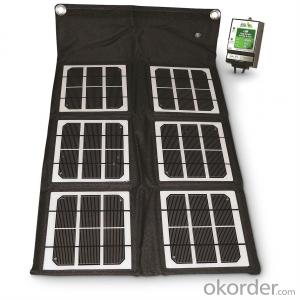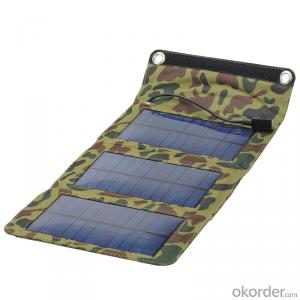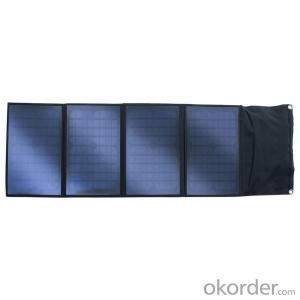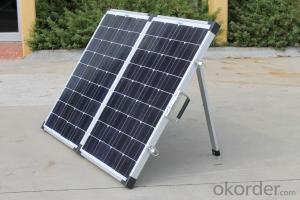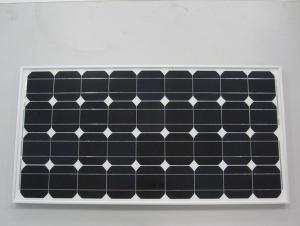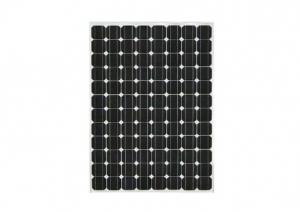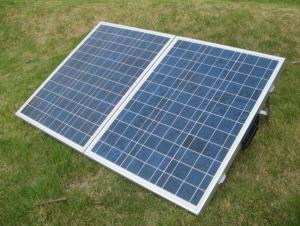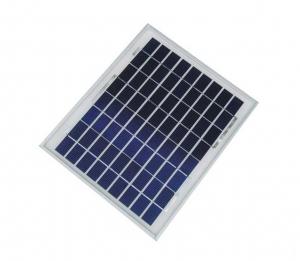Snow Rake Solar Panels:90W Folding Solar Panel with Flexible Supporting Legs for Camping
- Loading Port:
- Shanghai
- Payment Terms:
- TT OR LC
- Min Order Qty:
- 1000 watt
- Supply Capability:
- 10000 watt/month
OKorder Service Pledge
OKorder Financial Service
You Might Also Like
Specification
Product Description
Folding module kits are designed to provide portable 12 volt power wherever you need it.PoPwer available from 20W to 240W
Features:
· Padded, moulded carry bag
· Heavy duty carry handle, hinges and clasps Stainless steel telescopic&adjustable legs
· Weatherproof solar charge controller with LED indicator
· 5m cable with heavy duty Anderson connectors between module-regulator & regulator-battery clamps
· All cabled up ready to use
· 2 year warranty
These kits are the ideal solution for 4WD, camping, caravaning, boating and recreational activities whereverpower is required for lights, small TV, camping fridge, pump or other small appliances.
| Nominal Peak Power | 10W | 120W (2 x 60W) | 160W (2 x 80W) | 200W (2 x 100W) |
| Power tolerance | 3% | |||
| Cell type | Monocrystalline/Polycrystalline | |||
| Open circuit voltage (Voc) | 21.6V | |||
| Voltage at maximum power (Vmp) | 17.6V | 17.5V | 17.5V | 17.5V |
| Short circuit current (Isc) | 4.9A | 7.4A | 9.88A | 12.34A |
| Current at maximum power (Imp) | 4.54A | 6.86A | 9.14A | 11.42A |
| Maximum system voltage | 1000VDC | |||
| NOCT (Nominal Operating Cell Temperature) | 45 C +/-2 C | |||
| Operating temperature - module | -40 C to +85 C | |||
| Operating temperature – charge | -35 C to +55 C | |||
| Module folded size (mm) in carry bag | 505x550x60 | 505x825x80 | 505x1005x70 | 670x1005x70 |
| Module open size (mm) | 1014x550x30 | 1014x825x35 | 1014x1005x35 | 1344x1005x35 |
| Module net weight (kg) | 9.2 | 13 | 15.2 | 19 |
| Module gross weight (kg) | 11 | 16 | 19.4 | 23.2 |
| Solar charge controller | PWM 12V 10A; IP65 rated | PWM 12V 20A; IP65 rated | ||
- Q: what do I need to do to disconnect a solar panel from a battery to protect the panel?
- Know that solar panels almost always incorporate a blocking diode to prevent a battery from back-feeding through an un-illuminated panel. Know that solar panels are usually connected to a battery via an electronic switching charge controller, not directly connected. Know that when a solar panel is open-circuited (disconnected from everything) it's terminal voltage will rise to almost twice it's nominal voltage. (22V is common for a 2V panel), unless it is stored in total darkness.
- Q: How do solar panel power systems work?
- Solar power works by making solar cells of two kinds of glass; one which has been “doped” to have too many electrons, and the other which has been “doped” to have too few electrons. These layers of glass are then glued together with a thin insulation layer in between them. The top layer of glass is the one with too many electrons, the bottom layer of glass has too few electrons, and the insulation allows electrons to pass from the bottom layer to the top layer easily, but not from the top layer to the bottom layer as easily. As photons come flying into this glass sandwich at the speed of light, the photons crash into the electrons in both layers and cause them to start moving. The electrons in the top layer are tightly packed and can’t move much, but the electrons in the bottom layer can move around enough that they end up crossing through the insulation into the top layer. However, because there are already too many electrons in the top layer, the newly arrived electrons have no place to rest. This buildup of electrons creates an “electrical pressure”. Then contacts are glued to the glass top and bottom, and a wire is added to connect the top layer to the bottom, and the electrical pressure which has built up in the top layer now has a way to escape, and the extra electrons which crossed over the bottom to the top can now return to the bottom layer. This flow of electrons from the top layer to the bottom layer is the electricity generated by the solar cell. A solar “panel” is made up of many of these cells wired in series to increase the voltage to make it high enough to do some useful work, such as charging batteries, and many of these panels can be wired together to do such things as supplying power to a building, or even supplying power to the utility grid.
- Q: How much would solar panels cost for: A Cell phoneA average houseA car
- They would cost quite a bit but the user would likely be eligible for some energy credits from the power company and their cell phone carrier which would bring down the costs
- Q: I have a solar panel i got for free and I don't know what to do with it. Its kinda big at about 20x 0and it puts our 2 VOC / .23 ISC. I don't know of anything that I could use it for. Its too big to say charge a phone or ipod....any suggestions??
- Makes a great charger for a boat or car battery. I have one about that size that I have mounted on the fishing platform of my boat. The trolling motor battery is always fully charged when I need it.
- Q: So I want to power one of my car fans with some solar panels. I ordered quite a few and I want to power one of my fans under the hood. I've already disconnected the fan and pulled it out of the car to test it later.What all do I need besides the panels, fan, and wiring to make this work. This fan will not be tied to any other system. Currently, the fan is not operated by the car or any system of the car due to a modification made to the automobile allowing me to disconnect it from use months ago.Using the fan powered from the solar panels would help with the modification to increase air flow and speed into the area.Could someone please help me by telling me what else I need to make the fan operational from here?
- You may not like it, but the answer's still the same. A car fan will draw anything from a few to several hundred watts, depending on which fan you're talking about (A/C, ventilation, cooling). A solar array will take up roughly one square meter to generate 00 Watts with the sun shining straight down onto it, so you'll need to cover (more or less) the entire roof (or hood) with solar cells in order to power that fan (minimum). If you still want to go ahead: Solar panels, Fuse, cables. Preferrably one cut-out diode per panel (in addition to the hopefully present internal diodes in the panels) in order to prevent one panle dumping its load into the next instead of into the fan. Much better option: get a low power fan (e.g a slow running computer fan) and connect it to that panel of yours. These fans make do with about 0 Watts (at a much lower air throughput), so you'll actually have a chance of running it from the solar panel without coverig your car in panels.
- Q: Can solar panels be installed on airports or transportation hubs?
- Yes, solar panels can be installed on airports or transportation hubs. In fact, many airports and transportation hubs around the world have already installed solar panels as part of their sustainability initiatives. These panels help generate clean and renewable energy, reducing their carbon footprint and dependence on traditional energy sources. Additionally, the large open spaces available in these areas make them ideal for solar panel installations.
- Q: My family and I are looking into solar panels for our home. But I'm unsure how it would be priced. This month our home used ,623 kwh. The solar panel company said we should expect $6-$9 per watt used. What would that put as at?
- I don't know how they calculate out the savings, but ask your local supplier. The expensive part of heating hot water is the initial starting of the warming of the cold water, but this is where solar panels come to play a very good role in preheating home hot water cylinders. Sometimes the water coming from the solar panels is hotter than what the hot-water cylinder thermostat is set for this is one way you save money Another equally expense of heating hot-water is when the element thermostat keeps the temperature up to the desired setting of the thermostat. Where as having a solar panel or two the hot water cylinder is only a storage container to store the hot water in! A great invention in my book! The initial costs are buying these units having them installed, but over time you will start saving money on your heating hot water costs, where you will be able to waste a bit of hot water and not worry about the costs going to waste or down the drain... I suppose you know all of this, but I'm sorry, I can't convert your conversion question, best ask the supplier to put everything in layman's terms so you can understand it better more clearly! Cheers!!
- Q: Interested in buying solar panels to save on electric bill.Any government help plans?
- I don't believe that there is any help yet.
- Q: Can solar panels be installed on a restaurant or food service establishment?
- Yes, solar panels can be installed on a restaurant or food service establishment. Installing solar panels can help offset energy costs and reduce the carbon footprint of the establishment, making it a more sustainable and environmentally-friendly choice.
- Q: How many solar panels have ah?
- But in reality, the need for solar panel power and solar charger to find a balance in the portability. It is generally believed that the minimum power of the solar charger can not be less than 0.75w, and the secondary power solar panel produces 140mA of current under standard light. In the general sunlight generated by the current at 100mA or so, if less than the secondary power charging current is too small,
Send your message to us
Snow Rake Solar Panels:90W Folding Solar Panel with Flexible Supporting Legs for Camping
- Loading Port:
- Shanghai
- Payment Terms:
- TT OR LC
- Min Order Qty:
- 1000 watt
- Supply Capability:
- 10000 watt/month
OKorder Service Pledge
OKorder Financial Service
Similar products
Hot products
Hot Searches
